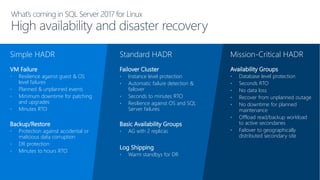SQL Server goes Linux - Hello, my name is Tux, I would like to join the #SQLFamily
- 1. Andre Essing Technology Solutions Professional Data Platform 10.06.2017 SQL Server goes Linux Hello, my name is Tux, I would like to join the #SQLFamily
- 2. Andre Essing Technology Solutions Professional Microsoft Deutschland GmbH Andre advises, in his role as Technology Solutions Professional, customers in topics all around the Microsoft Data Platform. He is specialized in mission critical systems, high-availability, security, operating and of course the cloud. /aessing @aessing aessingandre.essing@microsoft.com /Andre_Essing
- 3. The platform of your choice
- 4. SQL Linux Linux/Windows container Windows Windows Server • Linux distributions including Red Hat Enterprise Linux (RHEL), Ubuntu, and SUSE Linux Enterprise (SLES) • Linux containers for Docker engine on MacOS, Windows and Linux; Windows and Hyper-V container for SQL Server on Windows • Package-based installation, yum install, apt-get, zypper and more options
- 5. • Buying a SQL Server license per- server or per-core grants the option to use it on Windows Server or Linux • Same set of editions on Linux Developer, Express, Standard, Web, Enterprise LICENSE Licensing Same license, new choice
- 6. What’s coming in SQL Server on Linux Windows Linux GA Developer, Express, Web, Standard, Enterprise Database Engine R Services, Integration Services, Analysis Services, Reporting Services, MDS, DQS Maximum number of cores Unlimited TBD Maximum memory utilized per instance 12 TB TBD Maximum database size 524 PB TBD Basic OLTP (Basic In-Memory OLTP, Basic operational analytics) Advanced OLTP (Advanced In-Memory OLTP, Advanced operational analytics) Basic high availability (2-node single database failover, non-readable secondary) Advanced HA (Always On - multi-node, multi-db failover, readable secondaries) Security Basic security (Basic auditing, Row-level security, Data masking, Always Encrypted) Advanced security (Transparent Data Encryption) Data warehousing PolyBase2 Basic data warehousing/data marts (Basic In-Memory ColumnStore, Partitioning, Compression) Advanced data warehousing (Advanced In-Memory ColumnStore) Advanced data integration (Fuzzy grouping and look ups) Tools Windows ecosystem: Full-fidelity Management & Dev Tool (SSMS & SSDT), command line tools Linux/OSX/Windows ecosystem: Dev tools (VS Code), DB Admin GUI tool, command line tools Developer Programmability (T-SQL, CLR, Data Types, JSON) Windows Filesystem Integration - FileTable BI & Advanced Analytics Basic Corporate Business Intelligence (Multi-dimensional models, Basic tabular model) Basic “R” integration (Connectivity to R Open, Limited parallelism for ScaleR) Advanced “R” integration (Full parallelism for ScaleR) Hybrid cloud Stretch Database
- 7. What’s working already? Programming Features …and more! • Support for RHEL, SUSE, Ubuntu, Docker • Package based installs, Docker image • Support for Open Shift, Kubernetes, Docker Swarm, DC/OS • Failover Clustering & Availability Groups through Pacemaker • Backup/Restore • SSMS on Windows connected to Linux • Command line tools: sqlcmd, bcp, sqlpackage • SQL Server Agent • Replication • Log Shipping • Transparent Data Encryption • SCOM Management Pack • DMVs • Full Text Search Operations Features
- 8. Demo How to get started
- 10. System Architecture SQL Platform Abstraction Layer (SQLPAL) RDBMS IS AS RS Windows Linux Windows Host Ext. Linux Host Extension SQL Platform Abstraction Layer (SQLPAL) Win32-like APIs Host Extension mapping to OS system calls (IO, Memory, CPU scheduling) SQL OS API SQL OS v2 Everything else System Resource & Latency Sensitive Code Paths
- 11. High Availability & Disaster Recovery
- 12. What’s coming in SQL Server 2017 for Linux High availability and disaster recovery • Resilience against guest & OS level failures • Planned & unplanned events • Minimum downtime for patching and upgrades • Minutes RTO Simple HADR VM Failure • Protection against accidental or malicious data corruption • DR protection • Minutes to hours RTO Backup/Restore • Instance level protection • Automatic failure detection & failover • Seconds to minutes RTO • Resilience against OS and SQL Server failures Standard HADR Failover Cluster • AG with 2 replicas Basic Availability Groups • Warm standbys for DR Log Shipping • Database level protection • Seconds RTO • No data loss • Recover from unplanned outage • No downtime for planned maintenance • Offload read/backup workload to active secondaries • Failover to geographically distributed secondary site Availability Groups Mission-Critical HADR
- 14. SQL Tools Available Today SQL Server Data Tools (SSDT) SQL Server Management Studiomssql extension for VS Code AppDev DB / BI Dev DBA Sysadmin
- 15. What’s coming in SQL Server 2017 for Linux Tools and programmability • Windows-based SQL Server tools like SSMS, SSDT, Profiler work when connected to SQL Server on Linux • 3rd party tools continue to work • Native command line tools: sqlcmd, bcp, sqlpackage • Visual Studio Code extension • New cross-platform DB admin GUI tool (planned) • All existing drivers and frameworks supported
















